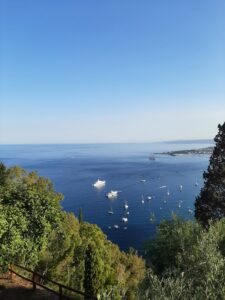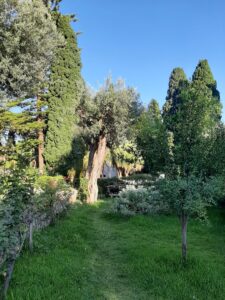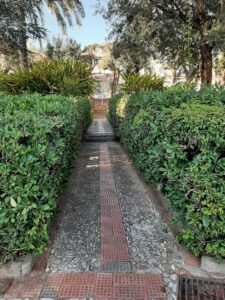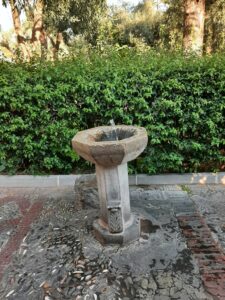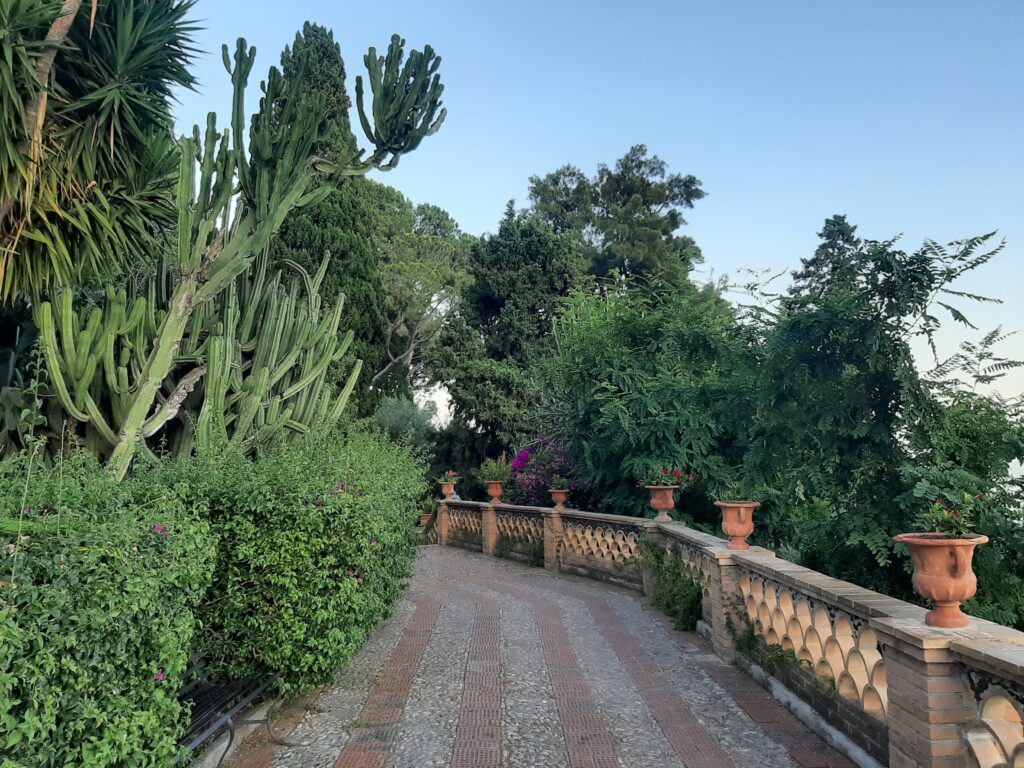If, while strolling through Taormina, you happen to turn onto Via Bagnoli Croce, you might find yourself in a place that feels lifted straight from a Victorian novel with a hint of Sicilian exoticism: the Villa Comunale di Taormina. But make no mistake—this is not just a public park. It’s a vibrant blend of history, royal intrigue, whimsical architecture, and curated botany. A place where time slows down and beauty turns into storytelling.
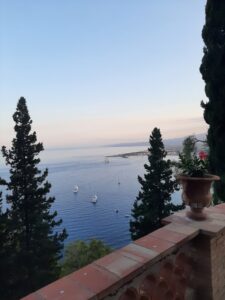 A noblewoman on the run and a botanical dream
A noblewoman on the run and a botanical dream
The star of this tale is Lady Florence Trevelyan, an English aristocrat who, in the late 19th century, was politely “asked” to leave the British court. Why? A rumored affair with the future King Edward VII—already married at the time. Rather than wallow, Florence packed her bags and set off on a Grand Tour that led her to Taormina, where she found not only sun and sea, but love: Dr. Salvatore Cacciola, who later became mayor of the town.
Florence wasn’t your typical woman. She adored nature, birds, rare plants, and eccentric structures. Between her marriage and a series of land purchases, she began planning the garden of her dreams. She called it “Hallington Siculo,” a nod to her childhood in Scotland. That dream blossomed precisely where today the Villa Comunale di Taormina now stands.
Victorian follies and Anglo-Sicilian pagodas
Wandering along the shaded paths of the Villa Comunale di Taormina, you’ll stumble upon peculiar structures that look like they belong in an oriental fairy tale. These are the famed Victorian Follies—small pavilions in eclectic style, with Arab, Gothic, and Eastern influences. Florence built them between 1890 and 1899, using lava stone, brick, and wood, and used them for birdwatching. Some locals refer to them as “beehives” because of their unusual shapes. And yes, they’re absolutely photogenic.
A garden that breathes
The Villa Comunale di Taormina is more than quirky architecture—it’s a green sanctuary where Mediterranean and tropical species flourish side by side. Olive trees, cypresses, palms, ficus, bougainvillea, agaves, and even exotic species like Erythrina crista-galli and Chorisia speciosa thrive here. Florence handpicked every plant with obsessive care, creating a botanical pathway that continues to enchant botanists and casual visitors alike.
And then there’s the view. From here, you overlook Mount Etna, the bay of Giardini Naxos, and the infinite blue of the Ionian Sea. It’s a privileged vantage point that has captured the hearts of artists, writers, and travelers across generations.
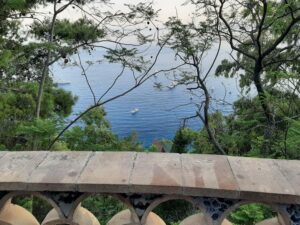 From private garden to public treasure
From private garden to public treasure
After Lady Florence’s death in 1907, the garden passed to her husband. But in 1923, Mayor Giovanni Colonna Duca di Cesarò made a historic decision to expropriate it and open it to the public. Since then, the Villa Comunale di Taormina has been the city’s public garden—open daily and free of charge. A generous act that turned a personal dream into shared heritage.
Curious details you wouldn’t expect
- Lady Florence requested to be buried on Mount Venere, behind Taormina, in a place nicknamed “a francisa”—since all foreigners were called that by locals.
- The garden is home to a vibrant colony of parrots that serenade visitors with lively birdsong.
- It’s one of the most photographed spots in Taormina—and paradoxically, one of the quietest and most contemplative.
A place that speaks to you
The Villa Comunale di Taormina is more than a garden. It’s a love letter to freedom, nature, and beauty. A sanctuary created by a woman who turned exile into poetry, leaving behind a legacy made of flowers, lava stone, and dreams.
If you ever find yourself in Taormina, don’t just glance at the garden—live it. Sit on a bench, listen to the birds, inhale the scent of the pines, and picture Lady Florence strolling through her follies, binoculars in hand and a sly smile. The Villa Comunale di Taormina is waiting to tell you its story—and maybe even yours.
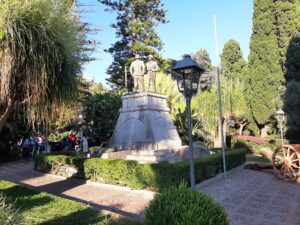 Villa Comunale di Taormina: the garden that whispers stories
Villa Comunale di Taormina: the garden that whispers stories
If you think a garden is just a place to walk, the Villa Comunale di Taormina will change your mind. This green corner nestled between the sea and Mount Etna is a living stage for stories, emotions, and visions. Every pathway, tree, and pavilion reveals something about Lady Florence Trevelyan, the English noblewoman who transformed exile into art.
Florence didn’t just plant flowers—she created a world. A world where rare plants mingled with whimsical constructions, where birdwatching became a near-spiritual practice, and where every corner was designed to awe, soothe, and inspire. Her Victorian Follies weren’t just decorative—they were soul shelters, towers for observing bird flight, small temples devoted to beauty.
And then there’s the light. That brilliant Sicilian light filtering through the leaves, stroking the lava stones, reflecting on the sea, and painting poetic shadows. Walking through the Villa Comunale di Taormina is like stepping into an impressionist painting, where each step is a brushstroke and each pause, a verse.
The garden is open every day, and entry is free. But the true cost is the risk of falling in love. With Taormina, with its history, with its natural wonders. And with a woman who, through courage and imagination, left a legacy that still blooms today.
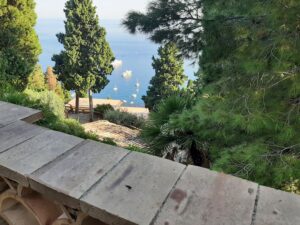 Villa Comunale di Taormina: where nature meets the soul
Villa Comunale di Taormina: where nature meets the soul
And then there’s that detail you won’t find in travel guides: the Villa Comunale di Taormina has a way of changing your inner rhythm. It’s not just the greenery, nor the view. It’s the whole experience. It’s the silence that feels respectful, the rustling leaves that sound like whispers, the parrots’ songs that remind you beauty can be playful too.
Walking along its paths feels like stepping into a parallel dimension, where time doesn’t rush but strolls gently, where every corner invites you to pause, observe, and breathe. The Victorian Follies, with their whimsical and poetic shapes, seem like fragments of Lady Florence’s dreams—and perhaps they truly are. She, who turned exclusion into creation, left behind a legacy measured not in square meters, but in emotion.
And then there’s the scent. The pine trees, the bougainvillea, the damp earth in the morning. A fragrance that clings to you even after you leave, like a gentle memory. The Villa Comunale di Taormina isn’t a place you simply visit—it’s a place you live. And once you’ve lived it, you never forget it.
